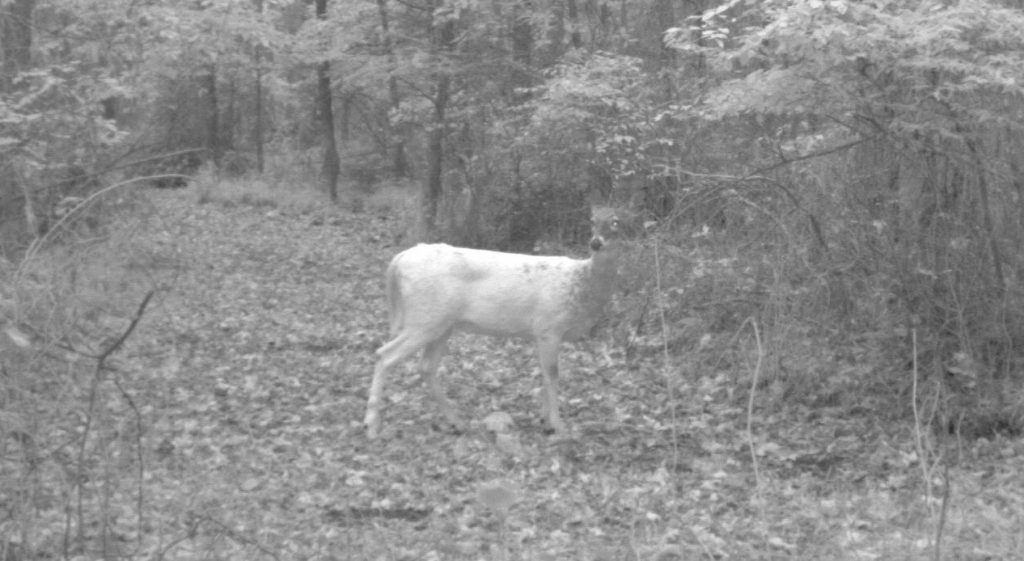[Pull up a chair and grab a cup of coffee (or something stronger) – this is a long one]
The white horse has special significance in many cultures. In Hinduism, the end of days is ushered in when Kalki descends atop a white horse. In Christian-based religions, one of the four horsemen of the apocalypse rides a white horse. While there are several interpretations of what the white horseman brings, one is infectious disease.
Either way, the white horse is not a good sign.
A paper was recently published entitled Chronic Wasting Disease Drives Population Decline of White-tailed Deer. Needless to say, it has been getting a bit of attention. If you haven’t heard of chronic wasting disease, please tell me where you live and if I can join you because it sounds like a nice place. I know more than I care to about this disease and none of it is good.
Chronic wasting disease (CWD) is a transmissible spongiform encephalopathy (TSE). Translation – it’s a contagious disease that creates holes in the brain if you are deer, elk, or moose. It is 100% fatal. It was first described in the 1960s in Colorado and Wyoming. No one outside of those areas really cared or paid much attention to it…until 2002 when it was discovered in Wisconsin…east of the Mississippi River…in a high density white-tailed deer population. It has now been documented in wild cervid populations in 21 states (PA joined the club in 2012). People pay attention now.
This disease is slow to progress (minimum 16 months between infection and development of recognizable symptoms) so it is difficult to detect. There are no mass mortalities or rapid population declines. But make no mistake, there are consequences. Like what will be the long term effects of a contagious 100% fatal disease on deer populations?
This is not an easy answer to obtain. Remember what I said about slow progression. Research takes years to conduct. So when this 8-year study was published a month ago, the title looked like that white horse!
What does it mean for the species? What does it mean for Pennsylvania?
The research was conducted in southeastern Wyoming and it estimated population vital rates (causes of mortality, pregnancy and recruitment rates, annual survival, disease prevalence) and modeled the influence of the disease on the population. CWD-positive and CWD-negative deer were monitored throughout their lifespan via radio-telemetry and GPS collars.
The study area is part of the historic CWD core area for white-tailed deer, mule deer, and elk. White-tailed deer were first sampled for CWD in 1999 (4 of 14 tested positive). Average annual CWD prevalence during the study period (2003-2010) was ~24% overall (males and females). Given the high prevalence and period of testing, it is likely CWD has been on the landscape since the 1970s.
Here are the details:
- 175 deer were captured and then recaptured annually
- CWD prevalence for captured animals was 35.4% and was higher in females than males (42% vs 28.8%)
- -Average annual CWD prevalence was 23.8% overall (24.3% for does, 23.1% for males)
- There were 118 mortalities with hunter harvest being the most common cause of mortality (46)
- More CWD-positive deer were harvested than expected
- 17 deer died of clinical CWD (12 of which were does)
- Bucks were more common in the harvest
- Age, CWD status, year, and body condition score did not influence pregnancy
- Average number of fawns per doe = 0.74
After gathering all the vital rates, the researchers modeled population parameters:
- CWD-positive deer were 4.51 times more likely to die annually than CWD-negative deer
- Bucks 1.70 times more likely to die than does
- Survival of yearlings and 2.5 years-olds was most severely reduced by CWD and had the greatest impact on the population
- Fecundity was not important and did not influence the model
- The majority of the population was found in the first three age classes followed by a rapid decline in older age classes
What?????
So what in the world does all this mean…in English?
CWD-positive adults were harvested at a higher rate than expected and before reaching terminal stages of the disease. Interesting. This suggests that there may be subtle behavioral changes in CWD-positive animals that make them more likely to be harvested.
CWD-positive bucks were harvested at a higher rate than expected and prior to reaching terminal stages of the disease. Does, on the other hand, had a lower harvest rate overall. Living longer than bucks, females were more likely to reach clinical stages of CWD. Females lived 30 weeks longer after testing positive than males. That’s over 7 months that CWD-positive females continue to shed prions (the disease causing agent of CWD) into the environment and directly infect susceptible animals.
CWD does not appear to affect reproduction (the rate at which fawns are born) in female white-tailed deer. Even CWD-positive animals can reproduce. Recruitment (the number of fawns that survive to the hunting season) wasn’t affected either, which means fawns were successfully reared until independence and inclusion in the population.
The model results using field data collected from this herd are alarming. It suggests the population is not sustainable possibly vanishing in 48 years given current levels of mortality and reproduction. This is a worst case scenario of disease transmission and no immigration or genetic selection for less susceptible genotypes for CWD.
Well that is not good. But before we go running to add this population of whitetails (or any population that is CWD-positive) to the endangered species list, let’s put this in perspective.
This population has a VERY high CWD prevalence, upwards of 20%, and has been infected almost a half-century. White-tailed deer have been hunted liberally in this area. Even with high disease infection and liberal harvest, the model’s worst case scenario suggests that it would take close to 100 years from disease establishment in the population to its complete removal from the landscape.
Ok, we can reduce to DEFCON 2 for the moment.
The model also shows that as CWD prevalence approaches 27% a different tactic in management is needed. When female hunting mortality is removed from the model at these high prevalences, a sustainable population resulted. So IF the model is correct, this CWD-positive southeast WY population of whitetails can be maintained if female harvest is discontinued.
DEFCON 3
What in the world does all this mean for Pennsylvania and the 10’s of other states that have CWD? Will the deer in DMA2 be gone in 50 years? Do we need to shut down doe harvest?
Thankfully, Pennsylvania is nowhere near the situation described in Wyoming. Our CWD prevalence, no matter how it’s measured, is well below 27%, 20%, or even 10% suggesting that we should still be focusing on lowering CWD prevalence by decreasing deer density. We are VERY far from switching objectives to that of maintaining a sustainable CWD-positive population. Whew!
And let’s not forget this is all based on a model. Granted the model is robust and well developed but a model nonetheless. It certainly can inform decisions for the future but it is NOT a future chiseled in stone.
Remember that white horse.
While the rider of the white horse may bring death and disease, they also signal the start of a new beginning. Warrior-heroes and saviors. CWD is not the end of days for the white-tailed deer but it’s certainly not the savior either.
It is something that will forever change how we manage deer. If we don’t want that to get too far from where we are now, then we better learn from others who are traveling with a white horse as well.
Biologist
If you would like to receive email alerts of new blog posts, subscribe here.
And Follow us on Twitter @WTDresearch

